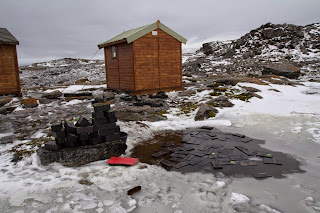This meant I had a lot to do- my first task was to get the rest of my penguin nest marker bricks out of the pond and wash them, then stack them into the huts. I managed to make a hole in the ice big enough to fish them out.

My next task was to start boxing everything up to send out on the ship. Every piece of cargo has to have paperwork to go with it, and every box has to be labelled on all sides with various information. As I am Science coordinator, this means I am responsible for shipping out all the lab equipment and biological samples, as well as the medical equipment and various other things. My lab became my temporary cargo packing area and was a little chaotic for a time, but by the necessary date, it was all neatly labelled and stacked ready for the ship.

We had a final day of fieldwork to complete, which allowed me to finish the giant petrel chick counts. Afterwards we brought back all the flags that mark a safe route over the icecap. We also managed to squeeze in a full base spring clean, before starting to decomission the services. First to go was the reverse osmosis plant which creates our fresh water from seawater. We have enough water stored to last a couple of days so we can take this apart a few days before leaving. In the last couple of days, the rest of the water systems are drained down, and every bit of pipework hoovered out to prevent pipes freezing over the winter. Shutters are placed on the windows and the elephant seal fence is taken down. All remaining food is packaged up and brought down to the main building as it remains the driest over the winter. There is a lot for everyone to do.
We were treated to a lovely sunrise on our last morning at Signy. A moment of calm beauty before the ship arrived and everyone started running around doing useful things.

On the final day, all cargo and waste gets put on the ship, the generators are switched off and serviced, the heating system is turned off, and finally, once the base is shuttered, cold and dark, we lock the door and board the ship.
Here is team Signy heading home (from back left: Rob, Stacey, Iain, Francesco, Keong, Matt, Roberto and Hector), with Signy behind.

And to finish the season, here is a final (and very lovely) iceberg just off the tip of Signy.

We arrived back in the Falklands on 19th March after a rough but uneventful crossing of the Drake Passage. I have now returned to the UK, where I will be spending the summer working at Foxglove Covert local nature reserve in Yorkshire. Check back in November to find out if I will be returning to the Antarctic next season.


